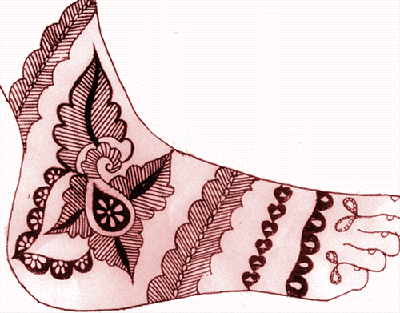

Mehandi is the Hindi word for a beauty treatment involving the crushed leaves of the henna plant. The leaves of this plant, when mixed with essential oils and water and applied to hair or skin, leave a beautiful reddish-brown stain that can last from several days to several weeks.
Also called mehandi or henna, mehndi has been a tradition in India, Africa, Eastern Europe and the Middle East for thousands of years. Women in these cultures ornament themselves with mehndi for weddings and other celebrations. The mehndi paste is piped onto the skin in ornate patterns, then kept moist as long as possible with lime juice, eucalyptus oil and sugar to allow the stain to deepen.

Mehndi is one of the sixteen adornments bestowed on a bride during Solah Shringar. In this way, mehndi marks the rite of passage of marriage in a girl's life and her initiation into womanhood.The intricate mehndi designs, which are painted on both the hands and feet, may contain a secret language. Designs include geometric and figurative motifs such as flowers and leaf and vine patterns, and traditional hindu religious symbols. Mehndi symbolizes satisfaction and happiness in marriage. This belief is connected with its red color which is also the color of the bride's dress. The process of applying the designs takes on a ritualistic aspect.
The mehndi is applied to the bride's hands and feet the night before the marriage ceremony by the bride's female relatives who spend several hours applying the designs. The process may take anywhere from three to eight hours depending upon the complexity of the designs and whether or not both the hands and feet are decorated.
Monday, February 25, 2008
Mehendi tradition in India
Mehendi art

The use of mehandi or henna became a significant part of Indian folk art soon after the advent of the Muslims. The orange-red mehandi color was often painted on new brides. The women were painted with intricate designs on order to distinguish them from unmarried young virgins, who were in danger of being kidnapped by the Muslims. From that time onward, it is said that mehandi flourished as decorative art in India.
The art form of applying henna (known as mehndi, mehandi or mehendi) varies from region to region. The varying designs can mean different things to each culture, such as good health, fertility, wisdom and spiritual enlightenment.
mehendi-moghul design

Decorating the bride's hand and feet with the application of henna or mehendi is symbolic of the auspicious occasion. Besides decorating the hands and feet it is a popular dye to colour hair. It is also used as a home remedy for various minor ailments.
In North India, application of mehendi is a common custom. For them this is an auspicious day before the wedding.Hindus consider mehandi as very dear to Lakshmi, Goddess of wealth and fortune. If ever there was a plant associated with luck and prosperity.
Mehendi-Jordosi Design

Mehendi, a common shrub is known to have been in use in all parts of the world since time immemorial.
The traditional way of painting hand and feet with mehendi is still popular especially among brides.

